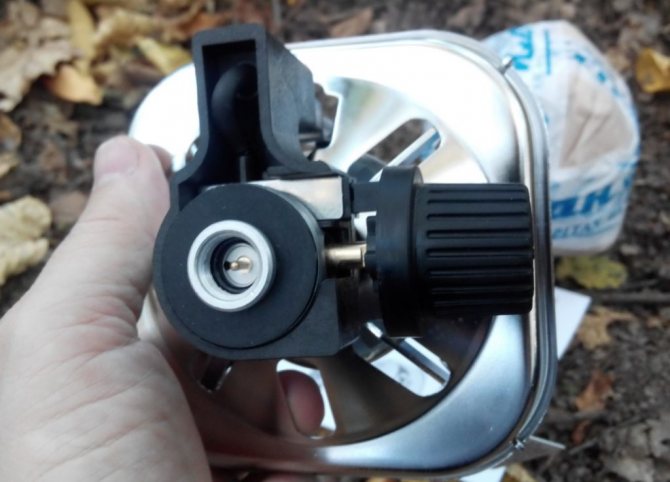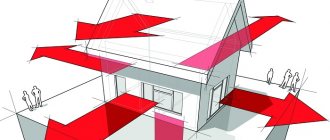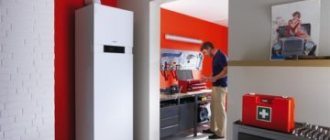Gas heating of residential and industrial buildings is carried out under the control of automatic control systems.
Modern technologies allow fine adjustment of a given temperature regime, while saving fuel. This result was achieved through the use of burners with power control function.
A gas burner is a device that mixes gas and air and burns this mixture in a combustion chamber.
Automatic temperature control system
The most primitive system for automatic control of a set temperature with the participation of a gas burner works as follows: gas is supplied to the burner, ignited by the ignition system, and stable combustion occurs. In this case, the burner operates at full capacity.
When a certain temperature value of the coolant or air in the room is reached, the burner goes out. To maintain the set temperature, it is constantly turned on and off.
Classification of gas burners by type of temperature control
With the development of technology, new, improved methods of automatic temperature control have been developed:
- Single-stage burners are primitive devices; their operating principle is described above. They work in the same mode.
- Two-stage burners are devices capable of operating in two modes (40 and 100% of total power), automatically switching between them.
- Smooth two-stage burners are burners operating in two modes (40 and 100%), but their switching between modes is carried out more smoothly, which significantly increases fuel economy and the quality of temperature maintenance
- Modulating gas burners are the most functional devices, capable of operating in a wide power range (from 10 to 100%). Such burners are capable of maintaining temperature conditions with a deviation of only 20C from the set value. At the same time, the efficiency of fuel combustion increases and the temperature loads on the elements of the heating unit are reduced.
The copper heat exchanger is the most efficient of all, as it has good thermal conductivity and thin walls.
But it does not tolerate high temperature stresses well, and therefore has a short service life. In combination with a modulating burner, its service life becomes longer. Gas burners with the ability to change the degree of combustion are expensive, but their efficiency will quickly pay for the costs:
- saving up to 30% of fuel;
- temperature is maintained within a narrow range;
- the service life of the entire unit increases.
Read about the benefits of installing a magnesium anode for a boiler in the article.
You will find information about TGE universal multi-fuel boilers at the link -
Find out how to properly piping boilers with polypropylene pipes.
Gas burner versions

Fan gas burner
In models with a fan (pressurized) burner, integrated fans direct air to the combustion department. With their participation, the efficiency of the boiler is seriously improved, and fuel is spent more economically. Atmospheric analogues are already included in the boiler upon purchase. And fan versions are additional devices. They need to be purchased separately.
A pressurized gas burner is usually used in devices with a closed combustion section, where the gas is instantly mixed with air supplied in portions. In appearance, they resemble a block in which a device for burning a gas mixture is connected to a fan. Modern models are automated, which guarantees the safe use of this gas equipment.
Supercharged GG can be vortex and direct-flow. The former have only circular exit holes. Secondly, both round and rectangular.
In wick fan devices, fuel is burned in an isolated compartment, which is done for safety when working with a gas boiler.
Advantages of ventilator generators:
- high efficiency.
- reliable heat exchanger design.
Their disadvantages:
- loud noises;
- dependence on the power grid;
- large waste of electricity;
- huge prices.
The noise is largely caused not by the fan, but by the gas-air flows leaving the nozzle of this generator under high pressure. In modern models, this shortcoming is eliminated by installing a muffler.
Although these burners have a number of disadvantages, thanks to them gas boilers work much more efficiently. Such burners are also used when the fuel is not gas, but fuel oil, wood, diesel fuel, or coal. When the fuel type is gas, the burner can operate efficiently, even if there are serious pressure surges in the main network.
To arrange the operation of a two-stage burner, there are two modes or varying fire power. If using one stage the boiler operates at its maximum, then when switching to the second stage, productivity is reduced by 50-60%.

Variation of modes in boilers is carried out automatically based on a signal from special sensors. They control the temperature of the coolant. Also, modes can change when the gas pressure in the main network changes.
Switching the boiler to a less tormenting mode has certain advantages:
- There is a saving of gas or other fuel.
- All equipment develops an operational period, as the number of starts and stops decreases.
A device with two stages can have a smooth change of modes.
Fan or forced-air burners operate by supplying air from the street using a fan. Fan operation is adjustable. Burners with external air supply operate stably at any gas pressure; for such boilers there is no need to make vertical chimneys, a coaxial chimney is sufficient; the efficiency of such boilers is close to 95%. True, they work noisily and cost 2 times more than atmospheric burners.
It is worth noting that fan burners are hung on the boiler. This makes it possible to change the burner and switch from gas to liquid fuel.
Technologies do not stand still and there are already combined burners for gas and liquid fuel on the market. Like any new technology, a combination burner costs an order of magnitude more.
Devices of this type are also called forced-air or blowing devices, since air is supplied to the combustion chamber using built-in fans. When used, the efficiency of the gas unit increases, which has a positive effect on economical fuel consumption. If atmospheric burners are included in the package of a gas boiler, then the fan burner is an additional equipment and must be purchased separately.
These devices are used in units with a closed combustion chamber. It is noteworthy that air is supplied to the burner in doses, and the mixing of gas and air occurs instantly.
Modern gas burners for heating boilers are characterized by a high level of automation. They are a block in which the gas combustion device itself is combined with a fan. And automation ensures safe operation of gas equipment.
Fan burners are divided into vortex and direct-flow. Vortex devices are equipped with outlet openings of only circular cross-section. For direct-flow supercharging devices, these elements can be round, in the form of a slot or rectangular in cross-section.
In fan-type wick devices, fuel burns in an insulated chamber, which provides additional safety during boiler operation. The advantages of these devices include the high efficiency of gas units, due to the special design of the heat exchanger.
The disadvantages of fan-type elements include:
- high noise level produced by the built-in fan
- energy dependence
- excessive consumption of electricity
- high cost compared to units equipped with atmospheric burners
The noise level is created to a greater extent not by the fan, but by the flow of gas and air coming out under pressure from the burner nozzle. To reduce this drawback, a muffler is installed in modern heating boilers.
However, despite the disadvantages and increased cost, fan burners increase the performance of a gas boiler. They can be used if fuel oil or diesel fuel, firewood or coal are used instead of gas. If the fuel is gas, then the pressurizing device operates effectively at any gas pressure in the main pipelines.
We invite you to familiarize yourself with: Do-it-yourself economical gas burner
They allow you to use gas, fuel oil or diesel fuel as fuel. This does not require additional dismantling or installation of equipment. One block combines functions for burning gaseous or other types of fuel. This is relevant for those homeowners who do not yet have mains gas, but they expect it in the future. Or for economical consumption of one or another type of fuel.
Such gas burners for heating are usually fully automated to control the combustion mode, flame power and other processes in the operation of the boiler. Smart automation allows minimizing human participation in controlling gas equipment.
The disadvantage of these burners is the rather complex process of switching the heating unit when changing the type of fuel, which requires high professional skills of a gas service specialist.
Basic elements of an automatic control system
Devices included in the electrical circuit of the burner for automatic operation:
- The maximum and minimum gas pressure switch has a simple design, which affects its long service life. Its principle of operation is that the gas pressure acts on the membrane, and if it deviates from the set value, it is triggered and the control valve makes the necessary adjustment. The minimum gas pressure switch protects against a drop in gas pressure to a critical value, and the maximum pressure switch carries out regulation, preventing the permissible value from being exceeded.
- The thermostat is an indicator of reaching temperature limits. According to its signal, the combustion modes change.
- The combustion controller is an element that combines the operation of the entire burner into a single process. The burner operation is divided into several points, which correspond to a certain position of the air damper and the fuel control valve. When a low temperature signal is received, the corresponding mechanisms open to increase combustion power. The controller's operation is based on signals from various sensors (pressure, temperature).
- Minimum and maximum coolant pressure relays protect the heating system from excessive drops and increases in coolant pressure. Both cases are dangerous for the continued operation of the boiler, therefore, when a critical value (lower or upper) is reached, the boiler turns off, that is, the gas supply stops.
- The boiler filling sensor is needed to provide protection against turning on the burner without the presence of coolant in the boiler.
Connecting the sensors depends on the brand of the boiler; this information can be found in the unit’s passport, and the specifics of connecting the sensors are described in detail in the attached instructions.
The connection and configuration of the automation system must be supervised by a gas service specialist. Commissioning work is also carried out in his presence with the mandatory drawing up of a certificate of suitability of the equipment for safe operation.
Atmospheric GG
These devices are used, as a rule, in low-power floor-standing boilers that can heat a private house with an area of up to 100 square meters. They are included with the gas boiler, which is set at the factory to consume natural gas. If there is a need to change fuel, then such a boiler will be converted to a different type of burner, and this should be done by a specialist.
The principle of operation of atmospheric wick elements is that air is supplied naturally to the place where it is mixed with gas and ignited. Ignition occurs using piezo ignition or electric ignition.
The design of such a burner is a hollow tube with numerous holes or several tubes into which gas flows under pressure.
The advantages of these devices include:
- reliability and simplicity
- safety
- noiselessness
- compactness
- light weight
Regarding the advantages of such units with this type of burner, we can say the following:
- It is possible to operate at low gas pressure (up to 15 mbar). This is especially true for the countries of the former CIS;
- high reliability of structural elements;
- there is no need for an additional fan or other mechanism for supplying air (there is a natural supply of oxygen to the boiler);
- wide range of different loads. When changing the latter, the burner operates stably;
- high level of silent operation;
- ergonomic operation due to simplicity of design.
We invite you to familiarize yourself with: Gas burner for Dutch oven
The disadvantages of this development are also obvious:
- since boilers have an open combustion chamber, there is potentially a threat of an emergency;
- The air intake diagram provides for certain operating conditions of the boiler. As a rule, boiler rooms are equipped in accordance with safety regulations.
As you can see, on the one hand, comfort and ergonomics are ensured, and on the other hand, the safety of the heating system is reduced. Heating of the room can reach 200 square meters. There are both single-circuit and double-circuit models. Thanks to its reliable design, the service life can last up to fifty years.
An atmospheric gas burner is installed in boilers with an open combustion chamber. The type of operation is very similar to a simple gas stove: gas enters the burner and burns when mixed with air coming from the room.
The positive features of an atmospheric burner are its simplicity of design and silent operation. Disadvantages: low efficiency (up to 90-93%) and rarefaction of air in the room. It is for this reason that such boilers are installed in specially equipped rooms, combustion chambers, which are equipped according to special rules.
There are several nuances in using imported atmospheric gas burners.
According to EU standards, the mains must have a stable gas pressure of at least 150 atmospheres. In Russia, these standards are similar, but may fall in winter and rise in spring. Such pressure drops lead to burner burnout in winter and heat exchanger burnout in summer. This means that in areas with unstable gas pressure it is better to use inflatable burners, the operation of which does not depend on gas pressure.

Atmospheric gas flame burner
Typically, such gas burners for boilers are used in floor-standing versions of boilers. The power of these units is small: the heating potential allows heating a building with an area of up to 100 sq.m. Another type of atmospheric burner (also called turbocharged) is suitable for gas boilers, which by default are set to use natural gas. In cases of fuel change, a different version of the GG is installed. This work should be entrusted to a specialist.
In atmospheric versions, air is directed to the gas connection area in a natural way. Methods for igniting such a gas mixture: piezo ignition or electric pulse.
The design of this burner is a hollow tube with many holes or a network of tubes in which gas moves under a certain pressure.
Turbocharged burner for gas boilers, its advantages:
- reliable operation;
- simplicity of design;
- safety;
- absence of noise;
- compact parameters;
- low mass.










